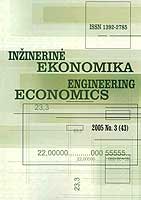The Tendencies of Strategic Industry Development in Lithuania
The Tendencies of Strategic Industry Development in Lithuania
Author(s): Diana LIPINSKIENĖ, Birutė Daraškevičiūtė, Rasa GLINSKIENĖSubject(s): Economy
Published by: Kauno Technologijos Universitetas
Keywords: milk industry; textile industry; export; import; comparative analysis.
Summary/Abstract: The article analyzes the changing tendencies and car-ies out the comparative analysis of Lithuania’s two major – milk and textile – industries. It is essential for Lithuania to maintain the competitiveness of these two industries in both domestic and foreign markets, promote production growth, and solve the problem of raw material shortages. The milk industry is one of the most important agricultural and food industry sectors producing about 18% of total agricultural output; milk-processing plants employ about ¼ of the total number of employees of the food sector. The textile industry is the 1st largest employer and is the 2nd largest according to the sales volume in the whole of proc-essing industry, with a positive trade balance. This sector is in the leading position of export – makes up about 20% of total exports of Lithuania. The milk sector is traditionally very important in Lithuania’s economy – it employs a large number of peo-ple and adds a large value. Lithuania’s membership in the EU is going to make a positive impact on this industry. Firstly, it is related to the support for agriculture – the cost of raw materials for the milk industry may go down. Sec-ondly, there are better opportunities for foreign trade – sales barriers within the EU countries have been reduced and opportunities for the export to the third parties in-crease in connection with export finance. Finally, this in-dustry enjoys a strong position in Lithuania’s market. The SWOT analysis of Lithuania’s milk and textile in-dustries demonstrated that they have favourable conditions for development, increase of the markets, but it is essential to pay attention to the arising threats in order to compete in the foreign markets and attract maximum investment. It is also important to compare the import and export change trends of these two industries and foresee the prospects of future development. While carrying out the import-export analysis of the abovementioned industries, it is obvious that both textile and milk industries remain traditional, with most priori-ties and being one of the most prospective in Lithuania. Both industries enjoy favourable natural conditions, big experience, well-qualified and inexpensive workforce. As the whole of industry in Lithuania, they are facing a number of difficulties. One of textile industry branches – flax textile is facing a shortage of raw-materials. The amount of flax grown in Lithuania cannot satisfy the needs of textile producers. They are forced to import the necessary amount of flax, and thus they have to deal with the imposed import tariffs. However, the enterprises manage to get the import quotas. The problems of Lithuanian milk industy also start with raw-material pro-duction, which is closely related to the quality and output of milk and its products. Relatively low productivity of Lithuanian cows is one of thse problems. Milk production is also seasonal.
Journal: Engineering Economics
- Issue Year: 2006
- Issue No: 2 (47)
- Page Range: 38-44
- Page Count: 7
- Language: English

